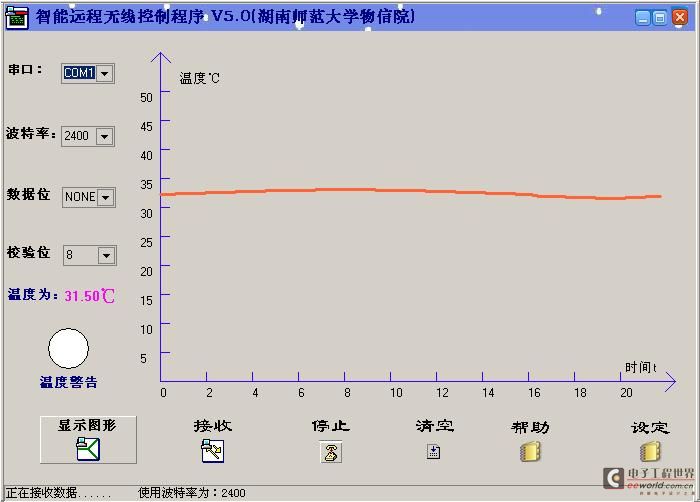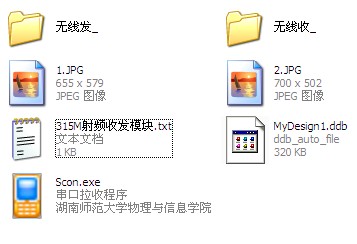51单片机+315M无线射频模块发射程序


压缩包中的内容:

上位机以及完整程序在文件夹中,大家可自己下载
地址是:http://www.51hei.com/bbs/dpj-19033-1.html
下面是发射端的源代码:
#include
#include "string.h"
sbit LED1 = P1^1;
sbit LED2 = P1^2;
sbit W_IN = P2^2; //电路是用11.0592MHz晶振
sbit W_OUT = P2^0;
sbit DQ =P2^1; //DS18B20数据口
unsigned char Te=0;//温度整数部分
unsigned char Te_D=0;//温度小数部分
unsigned char T0_last;
unsigned char w_data;//接收时用于存储两次上升沿之间的时长,发送时存储前半周
unsigned char send_busy = 0;//存储发送时后半周
unsigned char recv_timer = 0;
bit w_stat, last_w_stat;
unsigned char jiffies=0;
//定义通信端口
//延时函数
void delay(unsigned int i)
{
while(i--);
}
//初始化函数
Init_DS18B20(void)
{
unsigned char x=0;
DQ = 1; //DQ复位
delay(8); //稍做延时
DQ = 0; //单片机将DQ拉低
delay(50); //精确延时 大于 480us
DQ = 1; //拉高总线
delay(14);
x=DQ; //稍做延时后 如果x=0则初始化成功 x=1则初始化失败
delay(20);
}
//读一个字节
ReadOneChar(void)
{
unsigned char i=0;
unsigned char dat = 0;
for (i=8;i>0;i--)
{
DQ = 0; // 给脉冲信号
dat>>=1;
DQ = 1; // 给脉冲信号
if(DQ)
dat|=0x80;
delay(4);
}
return(dat);
}
//写一个字节
WriteOneChar(unsigned char dat)
{
unsigned char i=0;
for (i=8; i>0; i--)
{
DQ = 0;
DQ = dat&0x01;
delay(5);
DQ = 1;
dat>>=1;
}
delay(4);
}
//读取温度
void ReadTemperature(void)
{
unsigned char a=0;
unsigned char b=0;
unsigned char e=0;
//unsigned char t;
unsigned char c,d;
//unsigned char t=0;
Init_DS18B20();
WriteOneChar(0xCC); // 跳过读序号列号的操作
WriteOneChar(0x44); // 启动温度转换
Init_DS18B20();
WriteOneChar(0xCC); //跳过读序号列号的操作
WriteOneChar(0xBE); //读取温度寄存器等(共可读9个寄存器) 前两个就是温度
a=ReadOneChar(); //读取温度值低位
b=ReadOneChar(); //读取温度值高位
e=a&0x0f;//小数部分
c=(e*10)/16;
d=((e*10)%16)*10/16;
Te_D=c*10+d;
a=a>>4;
Te=b<4;
Te=Te|a;
}
void clock_timer(void) interrupt 1 using 1{
if (send_busy){
if(w_data){
w_data--;
w_stat = 0;
}else{
send_busy--;
w_stat = 1;
}
W_OUT = w_stat;
}else{
w_stat = W_IN;
if (w_stat != last_w_stat){
last_w_stat = w_stat;
if (w_stat){
w_data = recv_timer;
recv_timer = 0;
}
}
if (~recv_timer)//if(recv_busy != 0xff)
recv_timer++;
}
jiffies++;
T0_last=TL0;
}
void clock_init(void){
jiffies = 0;
TMOD=0x02;
TH0=TL0=0x0ce;//12M,50us
//TH0=TL0=0x7a;//16M
//TH0=TL0=0x75;//16.59M
//TH0=TL0=0x72;//17M
//TH0=TL0=0x37;//24M
//TH0=TL0=0x47;//22.1844M, 100us
//TH0=TL0=0xa3;//22.1844M, 50us
EA=1;
ET0=1;
TR0=1;
}
void clock_init_again(void){
TMOD=0x02;
TH0=0x0ce;//12M,50us
TL0=T0_last;
//TH0=TL0=0x7a;//16M
//TH0=TL0=0x75;//16.59M
//TH0=TL0=0x72;//17M
//TH0=TL0=0x37;//24M
//TH0=TL0=0x47;//22.1844M, 100us
//TH0=TL0=0xa3;//22.1844M, 50us
EA=1;
ET0=1;
jiffies=0;
TR0=1;
}
void init_serialcomm(void)
{
SCON = 0x50; //SCON: serail mode 1, 8-bit UART, enable ucvr
TMOD |= 0x20; //TMOD: timer 1, mode 2, 8-bit reload
PCON |= 0x80; //SMOD=1;
TH1 = 0x0e6; //Baud:2400 fosc=11.0592MHz :f4
TL1 = 0x0e6;
//IE |= 0x90; //Enable Serial Interrupt
TR1 = 1; // timer 1 run
RI=0;
TI=1;
}
void serial_out(char d){
while(!TI);
TI=0;
SBUF=(d);
}
void send_string_com(char *str,int strlen)//串口程序
{ char sum;
int k=0;
serial_out(02);
do
{ sum^=*(str+k);
serial_out(*(str + k));
k++;
} while(k < strlen);
serial_out(sum);
serial_out(03);
}
//等待指定长度的串行数据到达,超时值为每两个字节之间的间隔时间而非等待整个串的时间.
//超时单位为time_out * 100uS
bit wait_serial(unsigned char *p, unsigned char len, unsigned char time_out){
unsigned int time=jiffies;
unsigned char n=0;
do{
if (RI){
p[n++]=SBUF;
RI=0;
if(n==len)
return 0;
time=jiffies;
}
}while(jiffies-time < time_out);
return 1;
}
sys_init(){
clock_init();
init_serialcomm();
}
//=============================================================
//发送程序 开始
//=============================================================
51单片机315M无线射频模块发射程 相关文章:
- Windows CE 进程、线程和内存管理(11-09)
- RedHatLinux新手入门教程(5)(11-12)
- uClinux介绍(11-09)
- openwebmailV1.60安装教学(11-12)
- Linux嵌入式系统开发平台选型探讨(11-09)
- Windows CE 进程、线程和内存管理(二)(11-09)
